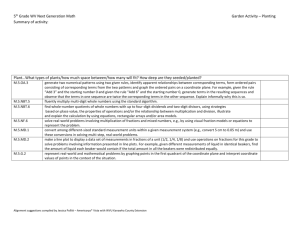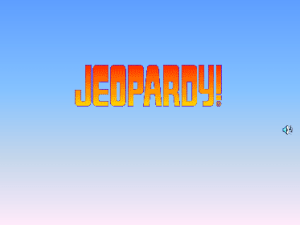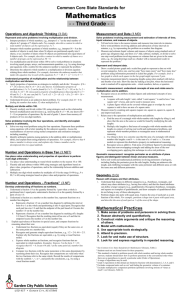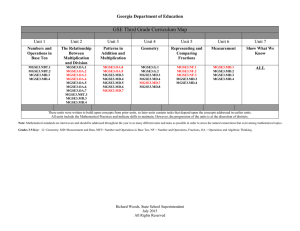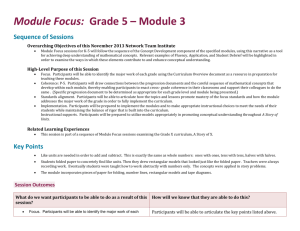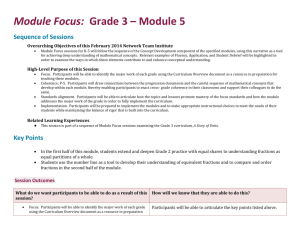3rd Grade Math checksheet – Tending
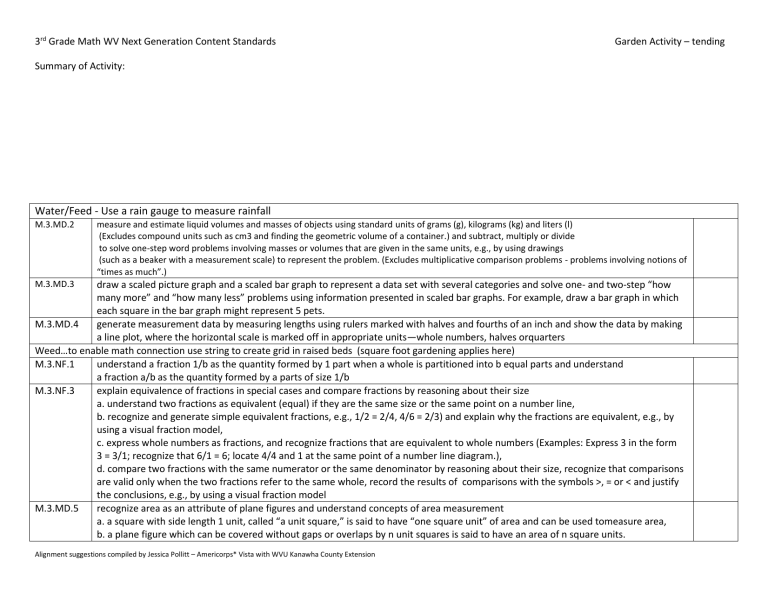
3 rd Grade Math WV Next Generation Content Standards
Summary of Activity:
Garden Activity – tending
Water/Feed - Use a rain gauge to measure rainfall
M.3.MD.2 measure and estimate liquid volumes and masses of objects using standard units of grams (g), kilograms (kg) and liters (l)
(Excludes compound units such as cm3 and finding the geometric volume of a container.) and subtract, multiply or divide
to solve one-step word problems involving masses or volumes that are given in the same units, e.g., by using drawings
(such as a beaker with a measurement scale) to represent the problem. (Excludes multiplicative comparison problems - problems involving notions of
“times as much”.)
M.3.MD.3 draw a scaled picture graph and a scaled bar graph to represent a data set with several categories and solve one- and two-step “how many more” and “how many less” problems using information presented in scaled bar graphs. For example, draw a bar graph in which each square in the bar graph might represent 5 pets.
M.3.MD.4 generate measurement data by measuring lengths using rulers marked with halves and fourths of an inch and show the data by making a line plot, where the horizontal scale is marked off in appropriate units—whole numbers, halves orquarters
Weed…to enable math connection use string to create grid in raised beds (square foot gardening applies here)
M.3.NF.1 understand a fraction 1/b as the quantity formed by 1 part when a whole is partitioned into b equal parts and understand a fraction a/b as the quantity formed by a parts of size 1/b
M.3.NF.3 explain equivalence of fractions in special cases and compare fractions by reasoning about their size a. understand two fractions as equivalent (equal) if they are the same size or the same point on a number line, b. recognize and generate simple equivalent fractions, e.g., 1/2 = 2/4, 4/6 = 2/3) and explain why the fractions are equivalent, e.g., by using a visual fraction model, c. express whole numbers as fractions, and recognize fractions that are equivalent to whole numbers (Examples: Express 3 in the form
3 = 3/1; recognize that 6/1 = 6; locate 4/4 and 1 at the same point of a number line diagram.), d. compare two fractions with the same numerator or the same denominator by reasoning about their size, recognize that comparisons are valid only when the two fractions refer to the same whole, record the results of comparisons with the symbols >, = or < and justify the conclusions, e.g., by using a visual fraction model
M.3.MD.5 recognize area as an attribute of plane figures and understand concepts of area measurement a. a square with side length 1 unit, called “a unit square,” is said to have “one square unit” of area and can be used tomeasure area, b. a plane figure which can be covered without gaps or overlaps by n unit squares is said to have an area of n square units.
Alignment suggestions compiled by Jessica Pollitt – Americorps* Vista with WVU Kanawha County Extension
M.3.MD.6 measure areas by counting unit squares (square cm, square m, square in, square ft and improvised units)
M.3.MD.7 relate area to the operations of multiplication and addition a. find the area of a rectangle with whole-number side lengths by tiling it, and show that the area is the same as would be found by multiplying the side lengths, b. multiply side lengths to find areas of rectangles with whole number side lengths in the context of solving real world and mathematical problems and represent whole-number products as rectangular areas in mathematical reasoning, c. use tiling to show in a concrete case that the area of a rectangle with whole-number side lengths a and b + c is the sum of a × b and a × c and use area models to represent the distributive property in mathematical reasoning, d. recognize area as additive and find areas of rectilinear figures by decomposing them into non-overlapping rectangles and adding the areas of the non-overlapping parts, applying this technique to solve real world problems
M.3.G.2 partition shapes into parts with equal areas and express the area of each part as a unit fraction of the whole. For example, partition a shape into 4 parts with equal area, and describe the area of each part as ¼ or the area of the shape.
Observe and discuss/represent - mathematically
M.3.OA.8 solve two-step word problems using the four operations, represent these problems using equations with a letter standing for the unknown quantity and assess the reasonableness of answers using mental computation and estimation strategies including rounding.
(This standard is limited to problems posed with whole numbers and having whole number answers; students should know how to perform operations in the conventional order when there are no parenthesis to specify a particular order (Order of Operations).)
M.3.NBT.2 fluently add and subtract within 1000 using strategies and algorithms based on place value, properties of operations and/or the relationship between addition and subtraction
M.3.MD.3 draw a scaled picture graph and a scaled bar graph to represent a data set with several categories and solve one- and two-step “how many more” and “how many less” problems using information presented in scaled bar graphs. For example, draw a bar graph in which each square in the bar graph might represent 5 pets.
M.3.MD.4 generate measurement data by measuring lengths using rulers marked with halves and fourths of an inch and show the data by making a line plot, where the horizontal scale is marked off in appropriate units—whole numbers, halves or quarters
Alignment suggestions compiled by Jessica Pollitt – Americorps* Vista with WVU Kanawha County Extension


